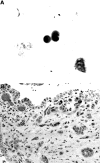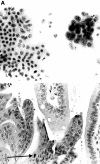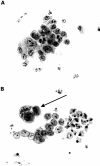Brush cytology in the assessment of pancreatico-biliary strictures: a review of 406 cases
- PMID: 11376018
- PMCID: PMC1731449
- DOI: 10.1136/jcp.54.6.449
Brush cytology in the assessment of pancreatico-biliary strictures: a review of 406 cases
Abstract
Aims: To assess the accuracy of brush cytology in patients investigated for pancreatico-biliary strictures.
Methods: All pancreatico-biliary brush cytology specimens submitted from two major teaching hospitals over a 6.5 year period were reviewed. Four hundred and forty eight satisfactory specimens from 406 patients with adequate clinical and/or pathological follow up data were examined in the study period.
Results: Two hundred and forty six patients (60.6%) were shown to have neoplastic strictures. One hundred and forty seven tumours were identified cytologically, including 87 of 146 pancreatic carcinomas, 29 of 47 cholangiocarcinomas, one of one bile duct adenoma, four of seven carcinomas of the gallbladder, eight of 13 ampullary carcinomas, two of three ampullary adenomas, 10 of 16 malignancies of undetermined origin, none of two islet cell tumours, one of three hepatocellular carcinomas, and five of eight metastatic tumours. The three adenomas identified on brush cytology could not be distinguished from adenocarcinoma morphologically. One hundred and sixty patients (39.4%) had benign strictures, most often as a result of chronic pancreatitis and bile duct stones. There were three false positive cytological diagnoses mainly as a result of the misinterpretation of cases with relatively scant and/or degenerative atypical epithelial cells. Forty one cases were reported as atypical or suspicious of malignancy on brush cytology, of which 29 were ultimately shown to have carcinoma. The overall diagnostic sensitivity and specificity were 59.8% and 98.1%, respectively. The sensitivity increased from 44.3% in the initial third of cases to 70.7% in the final third of cases examined in the series.
Conclusions: Brush cytology, in conjunction with other clinical and radiological investigations, is a useful technique in the assessment of patients with suspected pancreatico-biliary neoplasia.
Figures



Similar articles
-
Endoscopic brush cytology from the biliary duct system is still valuable.Dan Med J. 2013 Jul;60(7):A4656. Dan Med J. 2013. PMID: 23809967
-
Brush cytology of ductal strictures during ERCP.Acta Gastroenterol Belg. 2000 Jul-Sep;63(3):254-9. Acta Gastroenterol Belg. 2000. PMID: 11189981
-
Biliary brush cytology in the assessment of biliary strictures at a tertiary center in Iran.Asian Pac J Cancer Prev. 2011;12(10):2793-6. Asian Pac J Cancer Prev. 2011. PMID: 22320994
-
Brush cytology during ERCP for the diagnosis of biliary and pancreatic malignancies.Gastrointest Endosc. 1994 Mar-Apr;40(2 Pt 1):140-5. doi: 10.1016/s0016-5107(94)70155-5. Gastrointest Endosc. 1994. PMID: 8013810
-
Value of p53 immunostaining in pancreatico-biliary brush cytology specimens.Diagn Cytopathol. 2000 Nov;23(5):308-13. doi: 10.1002/1097-0339(200011)23:5<308::aid-dc4>3.0.co;2-h. Diagn Cytopathol. 2000. PMID: 11074623
Cited by
-
Application of brush cytology for FISH-based detection of 1p/19q codeletion in oligodendroglial tumors.J Neurooncol. 2016 Sep;129(3):415-422. doi: 10.1007/s11060-016-2211-0. Epub 2016 Jul 12. J Neurooncol. 2016. PMID: 27406587
-
Factors Associated with Malignant Biliary Strictures in Patients with Atypical or Suspicious Cells on Brush Cytology.Clin Endosc. 2019 Mar;52(2):168-174. doi: 10.5946/ce.2018.105. Epub 2019 Jan 9. Clin Endosc. 2019. PMID: 30625267 Free PMC article.
-
Integrating next-generation sequencing to endoscopic retrograde cholangiopancreatography (ERCP)-obtained biliary specimens improves the detection and management of patients with malignant bile duct strictures.Gut. 2020 Jan;69(1):52-61. doi: 10.1136/gutjnl-2018-317817. Epub 2019 Apr 10. Gut. 2020. PMID: 30971436 Free PMC article.
-
Comparison of liquid-based cytology (CellPrepPlus) and conventional smears in pancreaticobiliary disease.Korean J Intern Med. 2018 Sep;33(5):883-892. doi: 10.3904/kjim.2016.173. Epub 2017 Sep 13. Korean J Intern Med. 2018. PMID: 28899084 Free PMC article.
-
Role of peritoneal lavage cytology and prediction of prognosis and peritoneal recurrence after curative surgery for colorectal cancer.Ann Coloproctol. 2014 Dec;30(6):266-73. doi: 10.3393/ac.2014.30.6.266. Epub 2014 Dec 31. Ann Coloproctol. 2014. PMID: 25580413 Free PMC article.
References
MeSH terms
LinkOut - more resources
Full Text Sources
Medical
